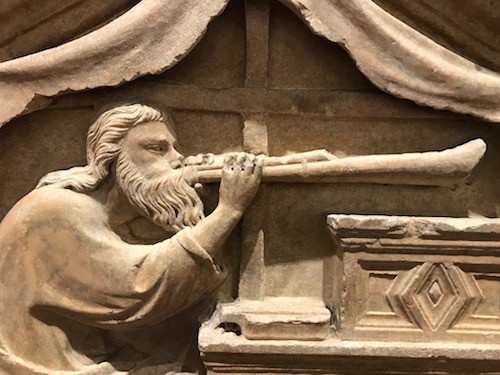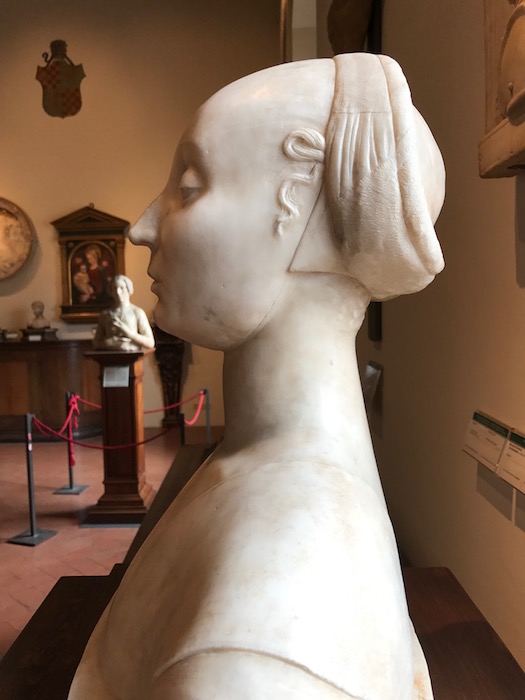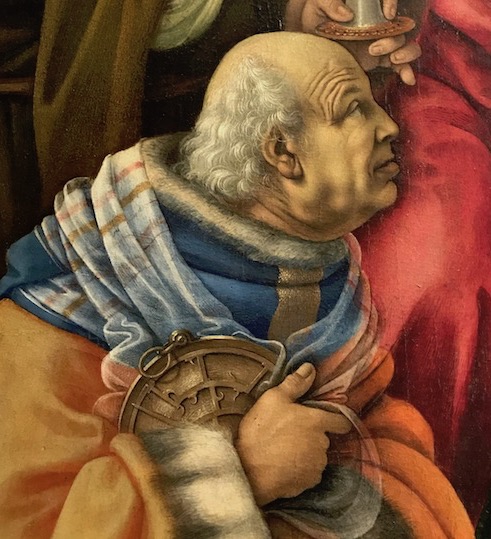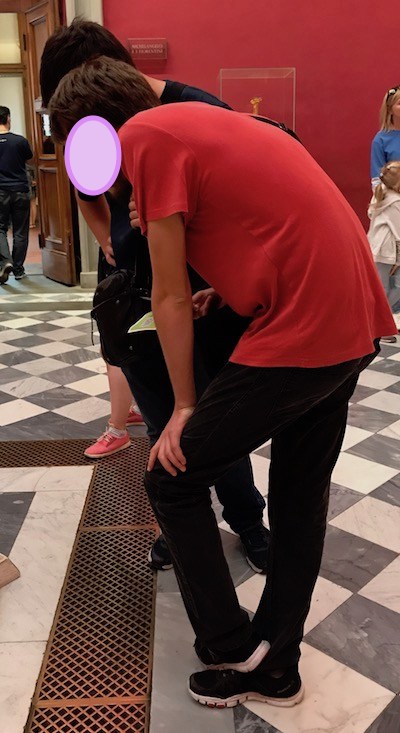The Alexander Technique has helped many people to move and breathe more easily, to stop pain and to heal injuries. To obtain these benefits, Alexander practitioners must pay special attention to the relationship of the head, neck and back.
F.M. Alexander's discovery
F.M. Alexander discovered that keeping the neck free of undue tension is a fundamental component of human well being. He discovered this after losing his voice while reciting on stage. Observing himself carefully, Alexander noticed that he was tensing his neck and tilting his head backwards whenever he spoke. After he stopped tensing his neck and pushing his head backwards, Alexander's vocal and breathing problems subsided. Over a 60-year career spent teaching thousands of students, he repeatedly confirmed the importance of the head-neck-back relationship.
Since Alexander made his discoveries 125 years ago, many have speculated about when humans began interfering with their head-neck-back coordination. The question will never be settled because the origin of human "misuse" predates Alexander's discoveries by millennia. Even so, art history can provide us with some useful insights, as I noticed during a recent road trip through Tuscany. During my travels, I examined many examples of Renaissance painting and sculpture. I appreciated these works for their sumptuous beauty, and for their portrayals of postural habits among people during the Renaissance.
Before discussing the art that I noticed during my travels, it's worth stating an obvious fact. Looking at art from 600 or 700 years ago is not the same as seeing people as they lived at that time. It's quite clear that many factors distinguish paintings and sculptures from life. These factors include an artist's interest in naturalism, her technical skill and her stylistic preferences. In addition, patron demands and patron budgets also weigh in the balance. With these factors in mind, we can use art to investigate human postural habits centuries ago.
Renaissance sculpture, seen through Alexander's eyes


These stone carvings are by the renowned sculptor Andrea Pisano (1290-1348). They are among 54 high relief sculptures that decorated the campanile of the Duomo in Florence, and that are now in the superb Museo dell'Opera del Duomo. The sculpture on the left symbolizes the art of music, while the one below depicts Daedalus in flight. In both cases, note the pushing forward of the neck away from the torso and the tilting of the head back on the neck. This is precisely the pattern of damaging misuse that Alexander observed in himself. It is precisely the sort of problem his Technique is designed to address.
These carvings demonstrate that human beings were misusing themselves at least 500 years before Alexander did. If these were real people instead of marble reliefs, their distorted postures would hinder their movements and restrict their breathing. We will never know why an eminent sculptor, working on a prestigious and highly visible commission, depicted people in these cramped attitudes. Pisano probably took his models from life, recognizing neither the aesthetic nor the health implications of the postures he carved.
Different artists, different portraits, different choices
The distortion in these sculptures is evident in many other works from this period. Of course, there are also works that do not exhibit the distortion. We can see this by comparing two portrait busts displayed in the same room at the wonderful Bargello Museum in Florence.


Both of these busts were sculpted in or near Florence by mature artists during the 1470s, so they are directly comparable. The one on the left, by Francesco Laurana (1430-1502), depicts Battista Sforza, the Duchess of Urbino. The one on the right is by Andrea del Verrocchio (1435-1488), but the model's identity remains a mystery.
Although comparable in many ways, these busts are far apart in terms of the poses they capture. The Verrocchio is striking for the grace, fluidity and naturalism of its carving, and it is also richly detailed. By contrast, the Laurana seems austere, stiff and rather unflattering to its powerful subject.
For our purposes, the key difference between these works lies in how each artist portrayed the head-neck-back relationship. In Laurana's piece, the head is tilted back toward the neck, and the neck is stiff and held, without the natural cervical curve being evident. Meanwhile, Verrocchio's model shows a head pointed forward and up, not back and down. Verrocchio carved a neck that is well integrated with the back, yet preserves the natural cervical curve. The result is a sculpture that is far more flattering to its subject and far more inviting to the eye.
It's tempting to attribute the differences between the busts to the skill level of their respective artists. And indeed, Verrocchio's carving exhibits much greater subtlety, nuance and finesse. Nonetheless, the stylistic preferences of the artists, as well as the preferences or budgets of their patrons, likely had a significant impact on these two sculptures.
Religious paintings display both sides of the same coin
There are also insights to be gleaned from religious paintings of this same period. In fact, most of these paintings are filled with portrayals of people distorting their head-neck-back relationship. This distortion arises because the divine is invariably on a higher level than the worldly. People must look up to express their devotion, and people often distort themselves looking up. Usually, the distortion consists of people pulling their necks forward while pushing their heads back. In Alexander parlance, this distortion is called "end gaining."
Notice the differences between these two figures of people looking up at Christ in two different paintings.


The figure on the left is from Fillipino Lippi's (1457-1504) sumptuous Adoration of the Magi, in the Uffizi. The figure on the right is from Pietro Perugino's (1446-1523) far simpler, yet equally magnificent, fresco of the Crucifixion in the Church of Santa Maria Maddalena dei Pozzi. Here, the distinction has nothing to do with skill — each painter has shown great mastery in his portrayal. However, the king on the left, and Mary Magdalene on the right, look up at Christ in very different ways.
The king shows Alexander's own habit of pushing the neck forward away from the torso, and tilting the head backwards on top of the neck. Meanwhile, Magdalene's neck is unencumbered by needless tension, and her head is delicately poised on top of her spine. She is using her eyes to look up, and not her neck.
As in the case of the two portrait busts discussed above, these two paintings were created by mature artists at virtually the same time in Florence. Even so, the contrast between these two figures could hardly be greater. This contrast could have been due to any number of causes, and it is unclear if the two painters were even aware of the starkly different choices they made in their portrayal of human devotional attitudes. It's a pity we can't go back in time and ask them both about their thoughts on this topic.
 Life imitates art, and vice versa
Life imitates art, and vice versa
In our daily lives, we are constantly being offered the same choice as the artists who made these paintings and sculptures. We can make preserving our head-neck-back coordination a priority, or we can ignore our own well being in service to our unconscious habits and our immediate objective. As noted above, Alexander Technique teachers call the latter of these two alternatives "end gaining."
We have the choice of whether to end gain, or not, even while we look at art. Here's an example of how one visitor to the Uffizi chose to examine a sign describing a sculpture. For no reason at all, other than unconscious habit, he is completely distorting himself here. His motive is to get closer to the sign, which is well below eye level. So he rounds his spine, hunches up his shoulders, pushes his head back on his neck, and balances on one leg. If he simply bent both his knees, none of these elaborate and uncomfortable maneuvers would be necessary.
We can choose to have a choice
The central problem of human behavior is this: a person has to be aware of what she is doing, and also aware of the available alternatives, before she can freely choose how she wants to be. This problem arises incessantly in Renaissance art, and it arises incessantly among people who are looking at Renaissance art.
We have an important choice to make, whatever our activity happens to be. That choice is whether we want to distort our postural coordination in service to our immediate goals or whether, instead, we want to pay attention to ourselves and make the task at hand secondary. Basically, it's a choice between promoting our own well being or "just getting the job done."
Renaissance art has valuable lessons to teach us about the origins of human misuse and about the possibility we always have of making a better choice. If we heed the unintended lessons offered by these masterpieces from the distant past, we'll be able to choose a better future for ourselves, free of pain and distortion. If we live this way, each of us can create and enjoy our own personal Renaissance.


Leave A Comment